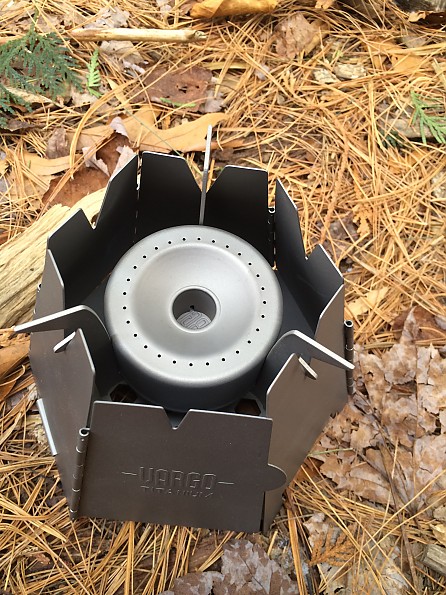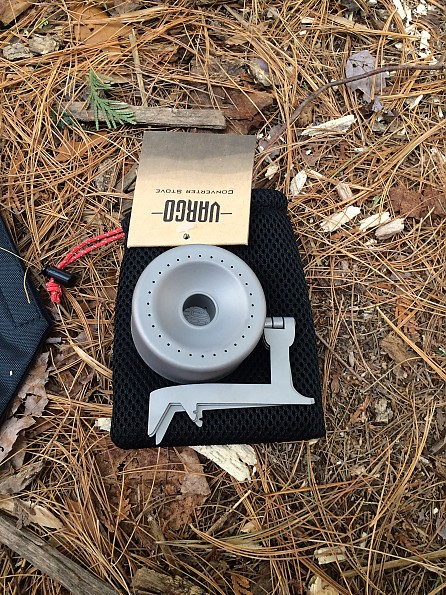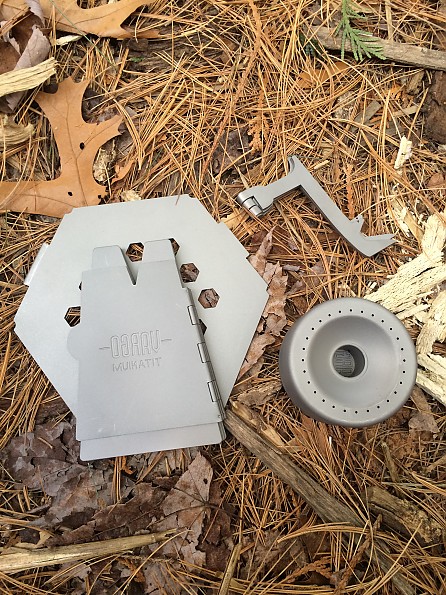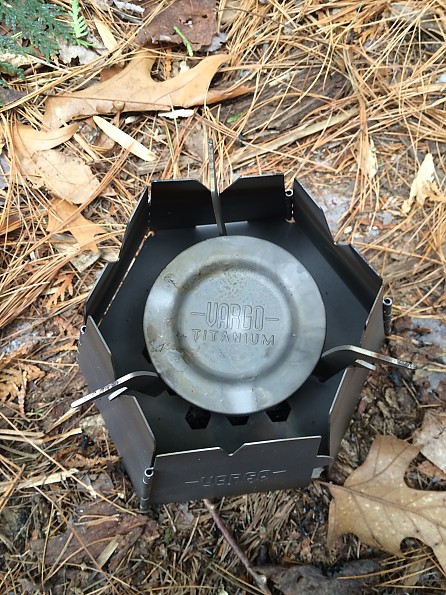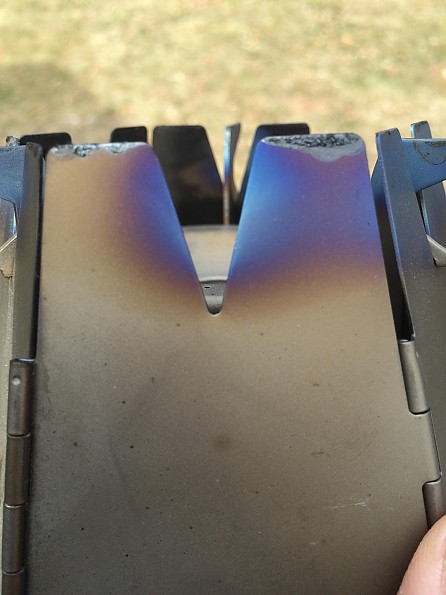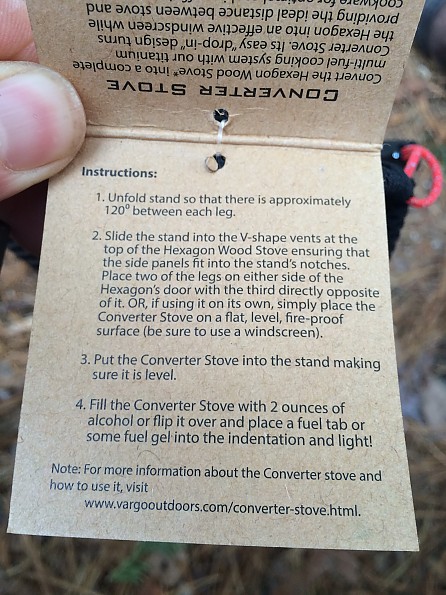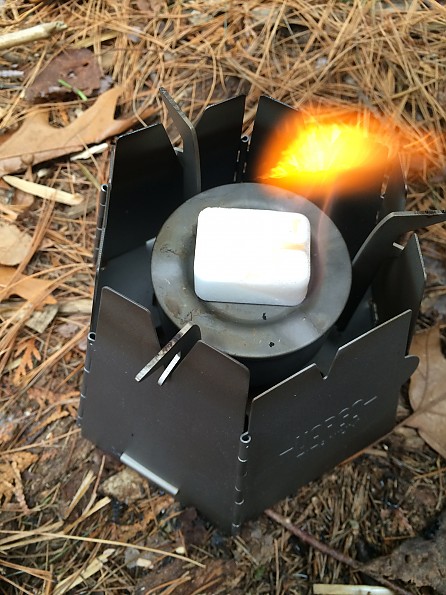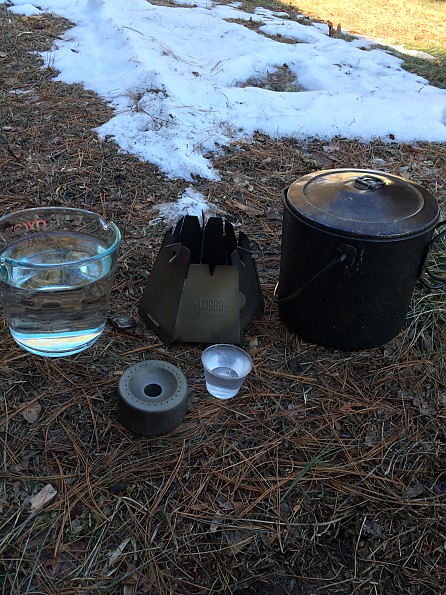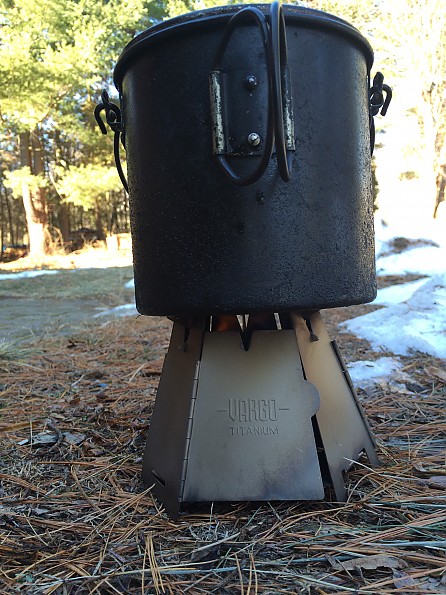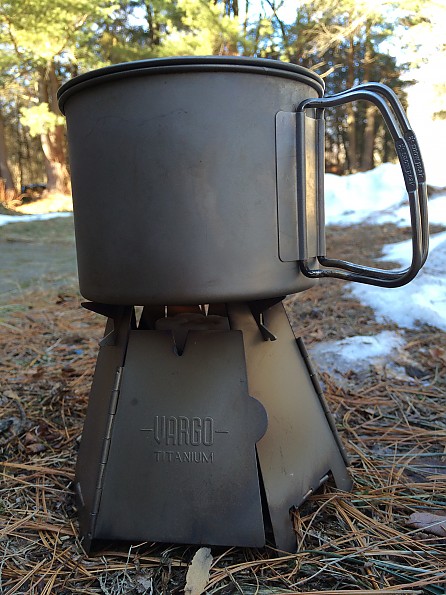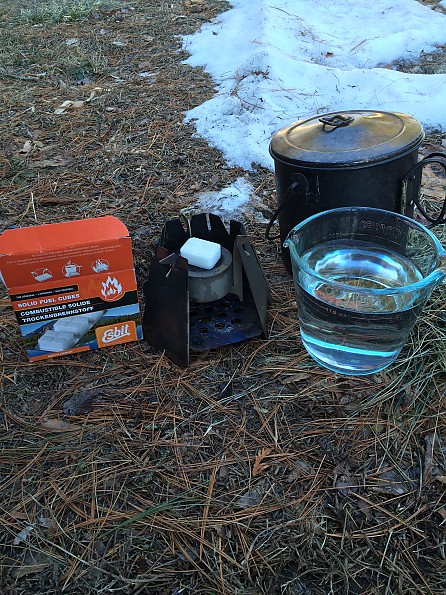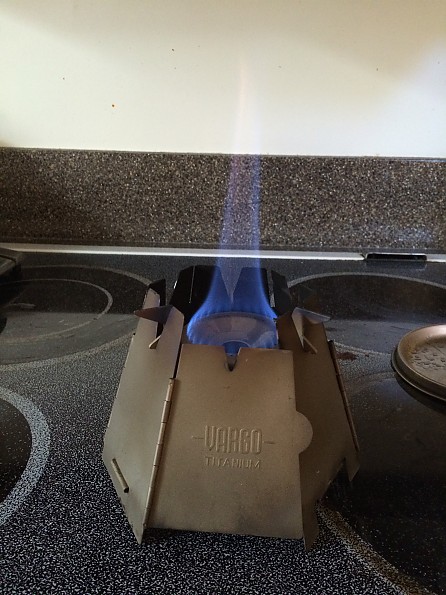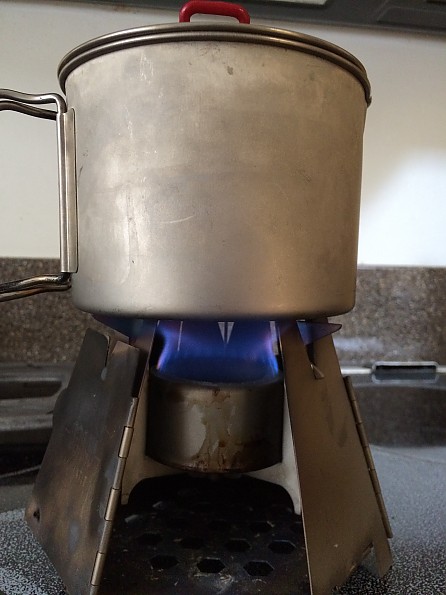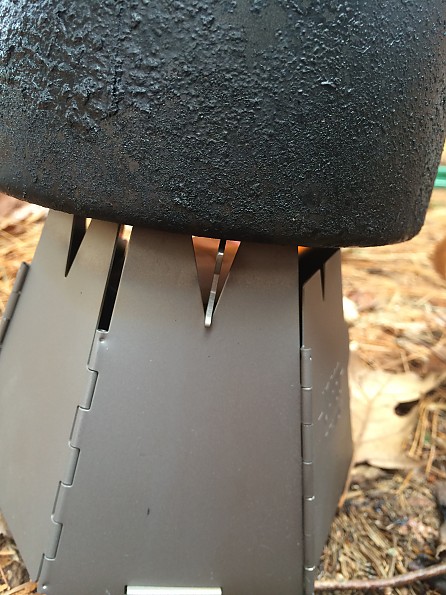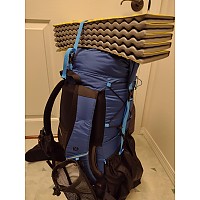Vargo Converter Stove
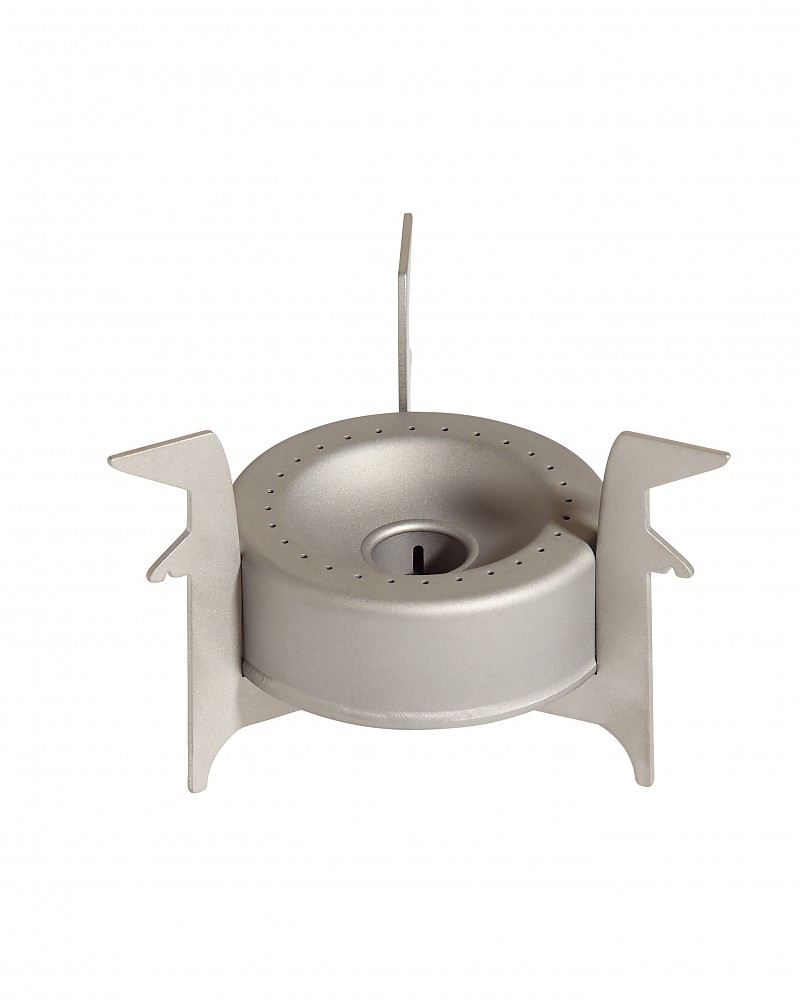
The Vargo Converter Stove is an optional multi-fuel accessory intended to be used with the Hexagon wood stove, although the Converter Stove can be used standalone as well. Multi-fuel capabilities include alcohol, esbit, or other fuel gels and solid fuel tablets. Sturdy titanium construction provides a lightweight stove that is far from fragile.
The Converter Stove is an option for anyone looking for a commercially available multi-fuel companion stove. I would say that there are better options available, but to my knowledge this is the only one you can purchase off the shelf at a major retailer.
I would only recommend this stove to someone if they routinely boil a liter at a time or simply want tough gear that will last a lifetime. Overall the stove's design needs some improvements, but if you want an alcohol stove that is tough as nails, this is it.
Pros
- Lightweight; 1.8 oz (1 oz for stove, .8 for stand)
- Well built and sturdy titanium construction; Won't crush if stepped on
- Available from mainstream retailers
- Multi-fuel options
- Pot stand folds flat
Cons
- Hexagon stove provides inadequate wind screen protection for Converter Stove in more than a moderate wind
- Converter Stove requires use of 2+oz of alcohol, or a priming pan for proper operation
- Difficult to reclaim unused fuel
- Titanium construction requires priming
While I rate the Converter Stove at 2/5 stars, I do want to take a moment to explain that rating before we get into the rest of the review. The cause of the rating being so low is the fact that this stove as it comes from the manufacturer requires using 2+ounces of alcohol to achieve proper and efficient operation. Using less than 2 ounces causes excessive priming times, that can be up to 20 minutes or never.
Once the stove has "bloomed" then it performs very well, and that, combined with a very tough stove that you don't have to baby, is quite nice. Operation once bloomed I would rate at 4/5. Durability and toughness I would rate at 5/5.
Please read the rest of the review, and watch some of the videos to fully understand this stove before making the decision if it is right for you or not.
Design and Construction:
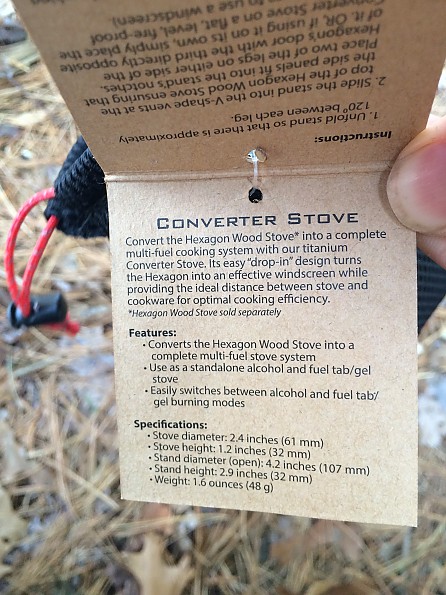
The Converter Stove is made of thick titanium, and is quite sturdy for its size. You will not have to worry about accidentally damaging or crushing this stove. Weighing in at exactly one ounce the overall construction is quite nice, and well finished, there are no sharp edges or other imperfections with the finish of the stove itself or the stand.
A folding stand accompanies the Converter Stove. This stand acts as the pot support and is also what suspends the Converter Stove inside of the Hexagon stove. It too is made of a thick, sturdy titanium. The stand has a bit of play in the hinge, providing very easy movement of the stand with practically no chance of it ever binding up. The stand folds flat for storage and weighs in at .8 of an ounce.
The folding stand has these notches in the arms that are designed to lock in place on the Hexagon stove to provide better stability. When the notches are aligned with the Hexagon walls the stove's as a whole are slightly sturdier, but I honestly found little difference if they were set in place “correctly” or not.
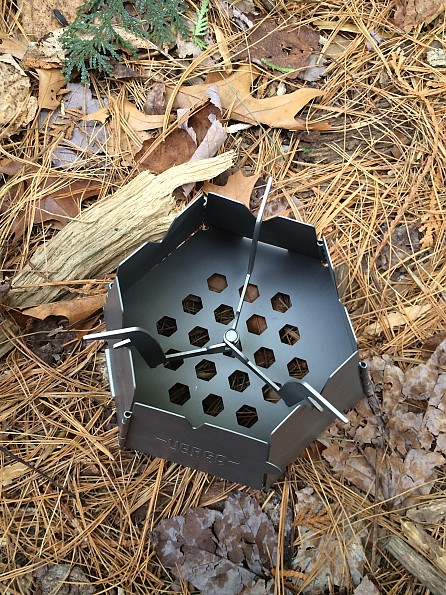
You can see in the below picture how the notches are not lined up. The Mors bush pot had 1 liter of water in it at the time, and no issues whatsoever.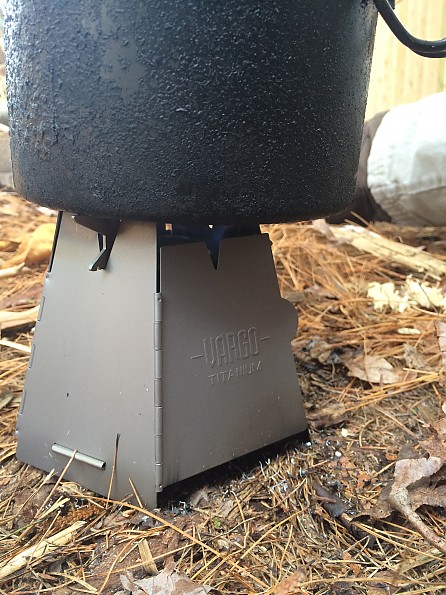
Switching between fuel types is very easy; just flip the converter stove over. One side of the converter stove is flat with an indentation for solid fuel tabs or gels, and the other side with the center well and holes along the rim are for alcohol. Up to two esbit cubes can be used at a time, or two ounces of alcohol.
Overall the stand and the Converter Stove itself both appear to be very well made with high quality materials, with excellent finishing. It is easy to notice that attention to detail was evident during the construction of this stove.
Here is a side shot of why the Hexagon is falling a little short with windscreen protection. These large V cutouts expose the top of the Converter stove allowing wind to make contact and distort the flame pattern. When using a large pot such as a Mors bushpot the effect is marginal, though with a smaller diameter pot it has a more adverse impact.
If the V cutouts were not there it would be significantly better in regards to using the Converter stove. There is a reason windscreens don't usually have a lot of holes in them, they let wind through.
Operation and Theory:
I have used a lot of alcohol stoves throughout the course of my backpacking career. Most of which I have built myself. This is the first mainstream commercially available alcohol stove I have used. Anything from cat can to penny stoves I have used. All of them worked, but some worked better than others.
Personally, I always seem to prefer alcohol stoves that don’t require a separate pot stand simply due to the fact that it is one less thing I have to carry and keep track of. Not wanting a separate pot stand is purely personal preference and does not affect the stove’s performance at all.
I often use a wood stove for backpacking here in the Northeast. Fuel is plentiful, and the atmosphere is generally safe to support their use in the backcountry. It can be a bit tedious at times though, and so the market began offering solutions. Those solutions have been to provide a companion stove to use in conjunction with them. When I roll over in my hammock at sunrise on a cold winter morning, the last thing I want to do is fiddle with a stove of any sort. I just want hot coffee…and sooner rather than later.
It is also handy to have a companion stove if it’s really foul or wet weather, or simply for those times where you’re too tired to spend a few minutes gathering up some wood. I have turned to alcohol stoves to fill this niche. A small alcohol stove and a few ounces of alcohol is all I need to carry on a trip if using it with my wood stove.
At first look the Vargo Converter stove appears very promising. But sadly, in operation it falls a bit short. It does work; it’s just that it reminds me of some of those less than stellar DIY alcohol stove designs that never really caught on.
Using an alcohol stove is simple, right? Well, sometimes it isn’t quite as simple as pour in fuel and light. I think this stove works wonderfully well once it has bloomed; getting it to bloom is the challenging part. I had a lot of difficulty getting the stove to bloom when trying to use less than two ounces of alcohol. I found that with the Converter stove you pretty much have to use a full two ounces in order for the stove to properly function.
Attempting to use the stove with only one ounce of fuel would always result in me having to use excessive fuel to prime the stove, resulting in around a total of two ounces used regardless. Pouring just one ounce of fuel in the stove and lighting it and doing nothing else would result in the stove taking over 15 minutes to bloom, sometimes as long as 20 minutes. Splashing fuel on the outside of the stove would aid in the stove blooming faster, but would still take 6-8 minutes often enough and adds in additional dangers of spilling ignited fuel onto the ground.
However, starting with two ounces in the stove would result in the stove only taking 1-2 minutes to bloom. If you fill the stove completely full, as in the cup on the top of the stop is filled as well, then the stove will bloom in under 30 seconds.
For this reason I feel that the Converter stove is best used when trying to boil larger quantities of water (1 liter). Two ounces of fuel is far overkill for two cups of water, which will result in having to attempt to reclaim unused fuel from the stove.
Sorry about the sideways video...silly amateur videographers.
The issue that I have with this is that most alcohol stoves only require around ¾ of an ounce to boil two cups of water, some take about one ounce. Generally speaking a pressurized stove such as this Vargo Converter stove will take closer to ¾ of an ounce, while an open burning stove will take closer to one ounce of fuel.
The Vargo however pretty much requires close to two ounces of fuel. This results in either having to carry more fuel, boil larger quantities of water at a time (to remain efficient), or extinguish the stove and attempt to reclaim the unused fuel. In my opinion the “backpacking standard” for alcohol stoves is being able to boil two cups of water with one ounce or under of alcohol, and being able to boil a liter with two ounces or under of alcohol.
Instructions for using the Vargo Converter Stove:
Alcohol stoves are generally rather intuitive to use. You just pour in the fuel and light. However, when a stove requires priming for proper operation its not quite as straightforward. The Vargo Converter stove’s instructions just say to pour in two ounces of alcohol and light.
I feel that there should be some expanded instructions on how to prime the stove. Someone brand new to backpacking or alcohol stoves may find this stove rather frustrating if they don’t know how to properly prime it.
There is another way to use the Converter stove, and that is with a solid fuel tablet such as Esbit. This is done by simply turning the stove upside down so that the side without holes is facing up. Placing the desired amount of fuel in the indentation and lighting it.
One Esbit cube is generally enough to boil two cups of water. Two Esbit cubes can comfortably fit on the Converter stove, and two Esbit cubes are ample to boil up to a liter. Esbit does leave a little residue behind on the stove, and can also leave some minor soot on the outside of your pot. Esbit is a good lightweight option for many backpackers. You can’t spill it, you can cut it up as needed to extend burn times, it however does smell something horrid.
Reclaiming unused fuel:
So you have extinguished the stove…you are certain it is extinguished, right? You have let the stove cool… the entire stove has cooled, right?
As you can probably tell where I am going with this, I think reclaiming unused fuel from an alcohol stove is a bad idea and not just bad, but very bad. However, if you are careful and pay attention to detail it is certainly doable.
The stove does not have a pour spout. You are trying to use the small holes all along the edge of the stove, specifically only a couple of them. The problem is that depending on how much fuel is left in the stove, and the size of container your trying to pour it back into, fuel may come out of one hole, two, three, or more depending how you tilt it. It isn’t exactly as simple as pouring water from a Nalgene into your pot without making a mess.
Even if you’re careful it is still very likely that you will spill at least some fuel. Luckily alcohol isn’t too damaging to the environment, and it evaporates quickly. So what’s the big deal?
Well, in daylight a flame from an alcohol stove is practically invisible. Combine that with parts of an alcohol stove being cool enough to pick up with a bare hand can provide a false sense of security resulting in you inadvertently pouring flaming fuel all over the ground, yourself, into your fuel container etc. It is also possible for the stove metal to still be hot enough to reignite fuel even if the stove has been extinguished i.e. when you begin to pour the fuel out the stove it reignites in your hand.
I am not trying to make this into a safety police review, but I do think it’s a bad idea. Be safe, be smart, and be certain of what you're doing before you do it. Many backcountry accidents have occurred with alcohol stoves. They deserve just as much respect as any other stove, failure to respect a liquid fuel and heat source can have dire consequences.
External Priming of the Vargo Converter Stove
The Converter stove as we have seen thus far is finicky about blooming depending on how much fuel you have in it. If you put over two ounces of fuel in the stove so that the cup on top is partially filled it will bloom very quickly, but unless you're trying to boil a liter or more, this isn't very practical.
So, why is this happening? Other alcohol stoves made from soda cans, cat food cans, etc bloom within seconds. Well, the Converter stove is made of titanium, thick titanium at that. Titanium has very poor heat transfer, and thusly it takes longer for the stove body to fully heat up and force vapors out of the jets.
By using a small priming pan under the stove you can see that the stove blooms very very quickly.
Field Use and Boil times:
I had the opportunity to test the Vargo Converter stove and the Vargo Hexagon wood stove for about two months. However, due to unforeseen circumstances I was only able to take this stove out on one three-night backpacking trip. However, that by no means means that it was not thoroughly tested.
I tried to do at least a dozen burns a week, two to three with wood, two to three with esbit, and five to six with alcohol. Testing was done in Connecticut, during January and February. Weather was rather mild overall for a winter in the Northeast United States, but we had some rather cold days as well. Both the Hexagon and the Converter were tested in temperatures from -10°F to 50°F. As well as controlled tests indoors around 70-75°F.
The very first time I used the stove I did one burn with each of the fuel sources, 1 wood, 1 alcohol, and 1 esbit. That first try was a failure for both the alcohol and the esbit, though the esbit fared much better. The main issue during those first attempts was the wind.
It was very windy, with sustained winds of around 20-25mph, with gusts up to 40-50mph. And it was a balmy 8°F with the mercury rapidly dropping. Now to be fair, esbit and alcohol are not exactly the first choice for winter backpackers due to the low BTU output of the fuel. But I wanted to see how they fared in the cold and the wind. I would never take an alcohol or esbit stove as my sole heat source on a winter trip.
The main goal of those first tests was to see how the stove performed in the wind. The Hexagon wood stove did not provide adequate wind protection in this scenario. It was an extreme condition test, and should be viewed as such. However, through the course of testing I found that the Hexagon overall failed to provide adequate wind protection. It provides some, but in anything other than a mild wind too much heat is lost resulting in steaming but not boiling water.
Winds less than 10mph with ambient temperatures above 32°F seemed to produce no meaningful impact on stove performance. Conversely winds less than 10mph with ambient temperatures below freezing 15-30°F, resulted in significantly increased boil times. Wind speeds above 10mph seemed to always have an impact regardless of ambient temperature, though boils could not be achieved with esbit or alcohol with winds above 10mph and ambient temperatures below 15°F.
In all conditions I was able to achieve boils using the Hexagon wood stove alone (burning wood). There will a separate review of the Hexagon posted.
Using the Converter in alcohol mode required me to learn how to get it to bloom, essentially you have to use two ounces of alcohol in order for the stove to work properly. You can either start with two ounces in the stove, or start with one ounce and douse it every few seconds until it heats up enough to bloom. Either way you end up using around two ounces.
Being unable to adequately and efficiently use a small amount of fuel in the stove is my biggest complaint. Most people do not need to use that much fuel at one time.
Boil Times:
*All testing times were done using the MSR Titan kettle. The Mors Bush Pot was used for comparison purposes only.
Indoors:
Approximately 50 indoor test burns were conducted using alcohol, and eight with Esbit. As you can see below for this testing both fuel sources were very comparable. Ambient temperature for all indoor testing was between 70-75°F.
Alcohol
- Fastest: 9 minutes 48 seconds
- Longest: 13 minutes 7 seconds
- Average: 10 minutes 35 seconds
Esbit
- Fastest: 9 minutes 33 seconds
- Longest: 12 minutes 22 seconds
- Average: 10 minutes 3 seconds
Outdoors:
Approximately 75 burns were conducted using alcohol, and 18 with Esbit. Outdoor tests were conducted with a wide range of temperatures and wind speeds. Ranging from -10°F to 50°F with wind speeds from 0-20mph.
Data is skewed due to winter weather. Times would improve closer to the Indoor times during milder weather. It is also important to remember that I also had numerous times where no boil was achieved.
Alcohol
- Fastest: 11 minutes 58 seconds
- Longest: 16 minutes 32 seconds
- Average: 13 minutes 29 seconds
Esbit
- Fastest: 10 minutes 25 seconds
- Longest: 13 minutes 36 seconds
- Average: 12 minutes 15 seconds
Conclusion:
It may be well made, it may look good, and it may be made out of titanium, but those three things don’t combine to make magic in this case. I think the overall design of the alcohol portion of this stove needs to be reworked. Being forced to use a full two ounces of fuel every time you want to boil water is an unwanted hassle for most backpackers.
Joined with the fact that ounces add up to pounds, this stove will probably not find its way into too many packs. If the Converter stove worked easily with only one ounce of fuel, this would be a very viable option. When someone is able to make a very functional stove at a fraction of the cost and weight of the Converter stove, I just can’t honestly see someone carrying more weight (fuel) just to use a titanium stove plagued with quirky issues related to the quantity of fuel used. Someone has to essentially carry double the amount of fuel they would otherwise need to.
However, if you routinely boil around a liter of water at a time then this stove can certainly be a very viable option. Please do not misunderstand my review of this product. I really do like the stove. I just think it’s absurd that it requires a full two ounces of fuel to work properly.
It works, kind of. Back to the drawing board with this one, Vargo!
Additional videos showing blooming issues, as well as a comparison of the Vargo Converter stove to another alcohol stove designed to be an alcohol-only companion stove for backpacking wood stoves.
Source: received for testing via the Trailspace Review Corps
(Sample provided by Vargo for testing and review)
Your Review
Where to Buy
You May Like
Specs
| Price |
MSRP: $39.95 Current Retail: $39.95 Historic Range: $39.95-$49.99 |
| Weight |
1.6 oz / 48 g |
| Capacity |
2 oz / 59 ml |
| Stove diameter |
2.4 in / 61 mm |
| Stove height |
1.2 in / 32 mm |
| Stand diameter open |
4.2 in / 107 mm |
| Stand height |
2.9 in / 32 mm |


